Limousine

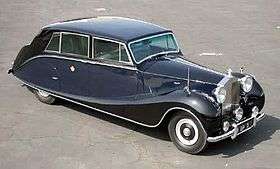
A limousine (/ˈlɪməziːn/ or /lɪməˈziːn/)[1] is a luxury vehicle driven by a chauffeur with a partition between the driver's compartment and the passenger compartment. A car with a partition and a lengthened wheelbase is called a "stretch limousine".
In some countries, a "limousine service" is a pre-booked hire car with driver, regardless of the type of vehicle.
In German-speaking countries, a Limousine is simply a sedan, while a lengthened-wheelbase car is called Stretch-Limousine.
Etymology
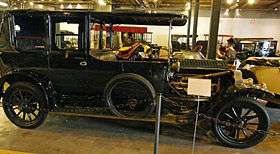 The type of limousine hood or roof described in the text (1912 Vauxhall) |
The word limousine is derived from the name of the French region Limousin. A particular type of carriage hood or roof physically resembled the raised hood of the cloak worn by the shepherds there.[2][3]
An alternate etymology has the chauffeur wearing a Limousin-style cloak in the open driver's compartment, for protection from the weather.[4] The name was then extended to this particular type of car with a permanent top projecting over the chauffeur.[2] |
History
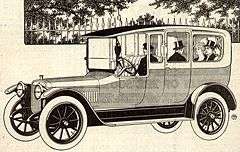
 Outside driver Rich owners of expensive carriages and their passengers were accustomed to their own private compartment leaving their coachman or driver outside in all weathers. When automobiles arrived the same people required a similar arrangement for their chauffeurs. The 1916 definition of limousine by the US Society of Automobile Engineers is "a closed car seating three to five inside, with driver's seat outside".[5] |
In the US sub-categories of limousines in 1916 were the berline defined as "a limousine having the driver's seat entirely enclosed", and the brougham, defined as "a limousine with no roof over the driver's seat."[5]
Other variations were the limousine-landaulet with a removable or folding roof section over the rear passenger seat, and the limousine de-ville, with a solid roof over the rear passengers but a removable or folding roof section over the driver's seat.[6]
Characteristics
The limousine body style has a partition separating the driver from the rear passenger compartment.[4][7] This partition includes a usually openable glass section so passengers may see the road. An intercom system may be supplied if requested.
Limousines are long-wheelbase vehicles to provide a suitably comfortable passenger compartment. There will usually be occasional or jump seats at the front of the compartment. Some of theses seats are mounted so they can face either way.
- Official state car of Queen Elizabeth II
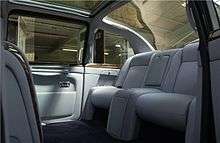 Passenger compartment of Queen Elizabeth's car with jump seats folded down
Passenger compartment of Queen Elizabeth's car with jump seats folded down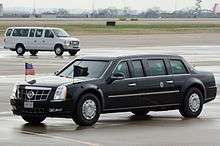 Cadillac One limousine of the President of the United States with the same seating arrangements
Cadillac One limousine of the President of the United States with the same seating arrangements
Stretch limousines
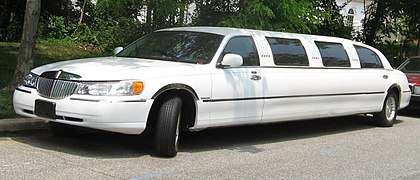
Stretch limousines are longer than normal limousines, usually in order to accommodate more passengers. Stretch limousines may have seating along the sides of the cabin.
A “stretch limousine” was created in Fort Smith, Arkansas, around 1928 by a coach company named Armbruster. Armbruster's cars were primarily used to transport famous “big band” leaders, such as Glenn Miller and Benny Goodman, and their bands and equipment. These early stretch limousines were often called “big band buses”.
Armbruster called their standard lengthened car products extended-wheelbase multi-door auto-coaches. Their "12-passenger people movers were used by hotels, taxis, airlines, corporations and tour companies".[8]
Novelty limousines
A variety of vehicles have been converted into novelty limousines.[9] They are used for weddings, parties and other social occasions.[10] Another style of novelty limousine are those painted in bright colours, such as purple or pink.[11]
Vehicles converted into novelty stretch limousines include the East German Trabant, Volkswagen Beetle, Fiat Panda, and Citroën 2CV. There are even instances of Corvettes, Ferraris and Mini Coopers being stretched to accommodate up to 10 passengers.
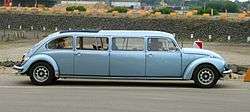 Volkswagen Beetle limousine
Volkswagen Beetle limousine Lada limousine in Cuba
Lada limousine in Cuba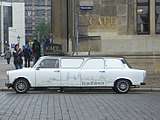 Trabant limousine
Trabant limousine
United States

The last production limousine, by Cadillac, with forward-facing jump seats was in 1987 (with their Fleetwood Series 75 model), the last Packard in 1954, and the last Lincoln in 1939, though Lincoln has offered limousines through their dealers as special order vehicles at times. Several Lincoln Premier cars were also built, one being owned by Elvis Presley. Vehicles of this type in private use may contain expensive audio players, televisions, video players, and bars, often with refrigerators. The President of the United States has ridden in a variety of types of limousine stretching back to 1899.[12]
In the United States the most popular vehicles for stretch limousines conversion are the Lincoln Town Car, Cadillac XTS, Cadillac Escalade, Chrysler 300, Hummer H2, Ford Excursion, and the Lincoln Navigator.
Stage

While lacking the separated drivers area required to be considered a limousine, a stage is a type of vehicle with similar usage. Its design and application is between a sedan and a bus. While a bus will have a central interior aisle for access to seating, a stage has multiple doors that allow access to transverse forward-facing seats. Stages were built by vehicle modification companies, based on sedans (e.g., Chrysler New Yorker, Cadillac DeVille, Checker Aerobus) and station wagons. Some stages included a large rack, running the length of the roof, for carrying the passengers' baggage.
An examples of stage usage is the Glacier National Park, where the stages were referred to as "Jammers" in reference to the nickname of their gear-jamming drivers.[13] Some funeral homes maintain six-door stages to carry the family of the deceased between the church and the cemetery.
United Kingdom
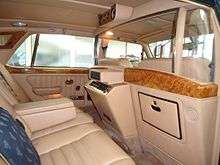
.jpg)
Due to the partition behind the driver, the London black cabs are a type of limousine. The jump seats, also referred to as taxi-tip-seats, usually carry advertising on the underside; the advertisements are visible to the passengers when the tip-seats are not in use.
Current limousine production
Limousines currently produced by vehicle manufacturers include:
- Cadillac One‡
- Cadillac XTS Limousine
- Chrysler 300 Limousine
- Great Wall Hover π
- FAW Hongqi Limousine
- Hyundai Equus Limousine
- IKCO Samand Sarir
- Lincoln MKS Limousine
- Lincoln MKT Livery
- Lincoln Navigator L
- Luxgen 7 CEO
- Mitsubishi Dignity
- SsangYong Chairman W Limousine
- Toyota Century Royal‡
- Aurus Senat Limousine‡
- Proton Perdana Limousine‡
- Proton chancellor‡
‡ = Only available for government customers
"Limousine service" hire cars
In the U.S., Canada and Australia, "limousine service" (also known as "car service") is the process of pre-booked hire of any car with a driver. The car is usually a luxury car, but not necessarily a limousine.
The difference between a limousine service and a taxi service is that limousines are pre-booked and cannot be hired on the spot.
See also
| Wikimedia Commons has media related to Limousines. |
References
- ↑ https://www.merriam-webster.com/dictionary/limousine
- 1 2 Dyke, Andrew Lee (1920). Dyke's Automobile and Gasoline Engine Encyclopedia (Twelfth ed.). p. 582. Retrieved 27 June 2015.
- ↑ Ayto, John (2009). Word Origins. A&C Black Publishers. ISBN 978-1-4081-0160-5. Retrieved 27 June 2015.
- 1 2 The Random House College Dictionary. Random House. p. 777. ISBN 0-394-43600-8.
1. an automobile having a permanently enclosed compartment for from three to five persons, the roof of which projects forward over the driver's seat in front...[< F, special use of limousine long cloak, so called because worn by the shepherds of Limousin, a former province in central France]
- 1 2 "What's What in Automobile Bodies Officially Determined". The New York Times. August 20, 1916. Retrieved 27 June 2015.
Here it is, with other body types and distinctions, officially determined recently by the Nomenclature Division of the Society of Automobile Engineers
- ↑ Haajanen 2003, pp. 93, 97.
- ↑ Haajanen, Lennart W. (2003). Illustrated Dictionary of Automobile Body Styles. Jefferson, NC: McFarland. p. 96. ISBN 0-7864-1276-3. LCCN 2002014546.
- ↑ Coachbuilt.com accessed July 19, 2018
- ↑ "Dave's Classic Limousines Pictures: Novelty Limousines". Retrieved 27 June 2015.
- ↑ Pedersen, Stephanie (2004). KISS guide to planning a wedding. DK Publishers. pp. 195–196. ISBN 978-0-7894-9695-9.
- ↑ Naylor, Sharon (2004). 1000 Best Wedding Bargains. Sourcebooks. p. 198. ISBN 978-1-4022-0298-8. Retrieved 27 June 2015.
- ↑ Huffman, John Pearley (19 January 2009). "The Secret Seven: The Top Presidential Limousines of All Time". Popular Mechanics. Retrieved 27 June 2015.
- ↑ Mulvaney, Tom (2010). Glacier National Park. Arcadia Publishing. p. 75. ISBN 978-0-7385-8080-7. LCCN 2009943323. Archived from the original on 28 November 2015. Retrieved 27 June 2015.